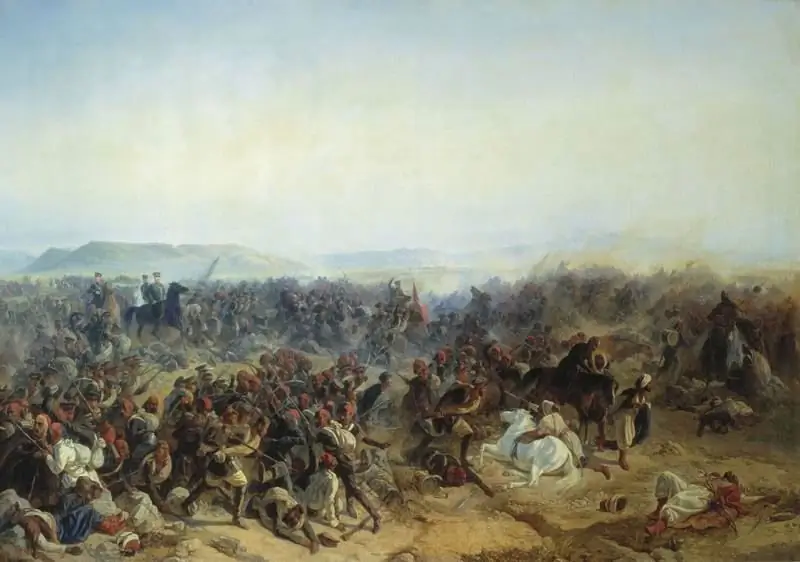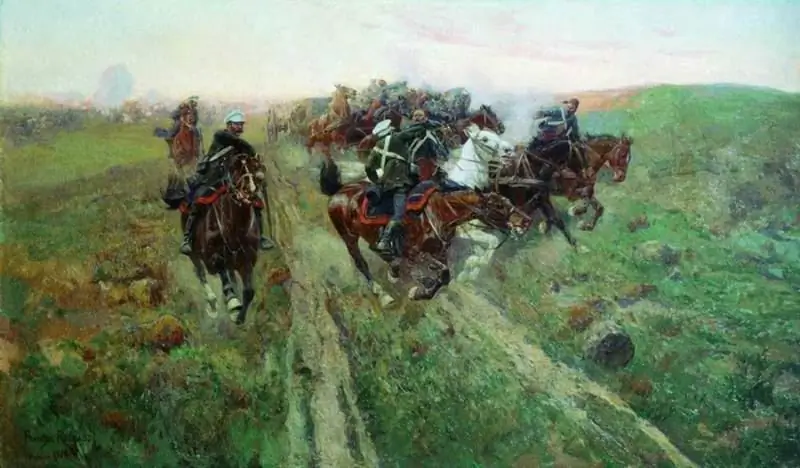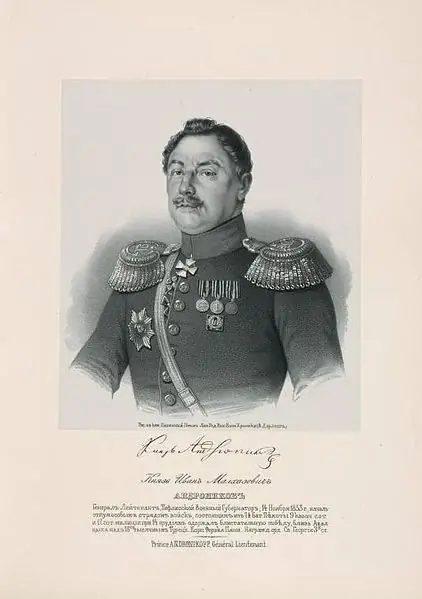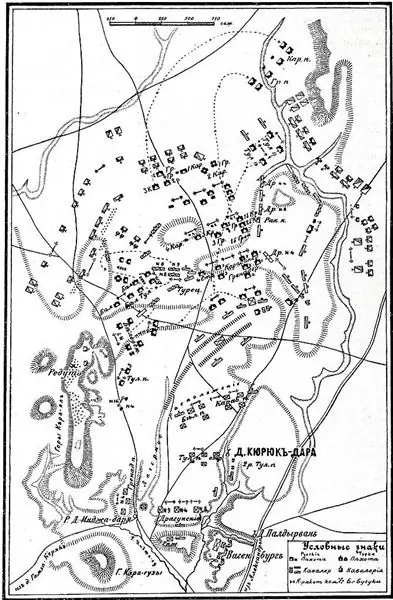- Author Matthew Elmers [email protected].
- Public 2023-12-16 21:49.
- Last modified 2025-01-24 09:17.
Victories of the Russian army in the Caucasus. 165 years ago, in August 1854, Russian troops under the command of General Bebutov defeated the Turkish army at the village of Kyuryuk-Dara in the Transcaucasus. The Russian army again thwarted Istanbul's plans to seize the Caucasus.

General situation on the Caucasian front
Winter 1853-1854 passed quietly, except for the raids of small Turkish detachments on border posts and villages. However, in the winter, with the help of British and French advisers, Turkey rebuilt and reorganized its army. For the West, the Crimea became the main theater of war, but Turkey was going to conduct the main military operations in the Caucasus. The Turkish Anatolian army was brought up to 120 thousand people. Its new commander-in-chief was appointed Zarif Mustafa Pasha, an experienced and brutal commander. The chief of staff was the French General Guyon. The Turkish army relied on powerful bases in Kars and Erzurum, had constant and convenient sea communications through Batum with the entire Black Sea coast and Istanbul.
The Turkish high command did not abandon plans for a breakthrough to Kutaisi and Tiflis, and further to the North Caucasus. To capture the capital of the Russian Caucasus, the 50-thousandth Batumi corps was allocated under the command of Mahomet Selim Pasha. The strike was planned through Guria, and on the coastal flank of the Ottomans was to be supported by the Anglo-French fleet, which now dominated the Black Sea. The Russian fleet was blocked in Sevastopol.
The situation was complicated by the fact that Russia had a bad connection with its possessions in the Transcaucasus. Communication by sea with Abkhazia and Redut-Kale was interrupted by the appearance of the western fleet in the Black Sea. The Georgian military road was unreliable and dangerous due to natural conditions (snow blockages, mountain falls, etc.), and the attacks of the mountaineers. The third route along the coast of the Caspian Sea gave communication only with Dagestan, and was also under the threat of attack by the mountain tribes. Only the fourth route remained - through the Caspian to Derbent, Baku and the mouth of the river. Chickens. With the advent of the Anglo-French fleet in the Black Sea, the fortifications of the Black Sea coastline had to be abandoned (they were too small and poorly armed to withstand the attack of the enemy fleet). Only Anapa and Novorossiysk decided to defend, strengthening their defenses. However, they managed to do little.
The enemy in the Batumi direction was opposed by two detachments under the general command of Major General Andronikov. The Gurian detachment was commanded by Major General Gagarin - 10, 5 infantry battalions, 2 Cossack hundreds, up to 4 thousand local militia and 12 guns. The Akhaltsykh detachment was headed by Major General Kovalevsky - 8 infantry battalions, 9 Cossack hundreds, about 3,500 militia and 12 guns.

Battles at Nigoeti and the Cholok River
The Ottomans were the first to launch an offensive on their left flank. At the beginning of June 1854, the forward forces of the Batumi corps under the command of Hasan Bey (about 10 thousand people) tried to defeat the Russian Gurian detachment on the banks of the Rioni River. In response, Prince Andronikov ordered Eristov's detachment (two battalions and 4 guns) to occupy the Nigoetsky heights. On June 8, in the battle near the village of Nigoety, Russian troops under the command of Colonel Nikolai Eristov utterly defeated the enemy. The Russians were surrounded, but several decisive bayonet attacks decided the outcome of the case in their favor. The Turks lost only in killed up to 1 thousand people. Our troops captured two cannons and a large number of new French guns.
After that, Andronikov's troops moved to Ozurgeti, where the defeated enemy detachment retreated. The Gurian detachment numbered about 10 thousand people with 18 guns. The 34-thousandth Batumi corps of Selim Pasha was walking towards the Russian troops. The Turks settled down beyond the Cholok River, erected fortifications. Their right flank was covered by a steep, inaccessible ravine, the left - by a dense mountain forest, indented by gorges. The only weakness of the Ottomans was their artillery: 13 guns versus 18 from the Russians. The Gurian detachment reached the river on June 3 (15), 1854. Reconnaissance showed the strength of the Turkish position, and the Ottomans fought well on strong fortifications. However, the council of war decided to storm the enemy camp.
In the early morning of June 4 (16), 1854, crossing the narrow Cholok River, our troops attacked the enemy camp. The case began with a clash between the advanced patrols of the Gurians of Prince Mikeladze and the Turkish posts. Gurian militiamen selflessly fought for their land. They overturned the enemy, the Turks fled to their camp. Part of the militia started a firefight with the enemy on the right flank of the Turks, creating the appearance of preparing an attack through the ravine. At this time, our main forces were preparing for an attack, an artillery duel began. Meanwhile, the Gurians, carried away by their first success, in pursuit went to the Turkish camp. From there a Turkish battalion set out with a gun. However, the militias rushed bravely into hand-to-hand combat and, unexpectedly for the enemy, caused great confusion. The Turks fled to the camp, abandoning the cannon and the banner.
The first success was the signal for a general attack. The Russian infantry rushed forward. The huntsmen, working with bayonets and rifle butts, seized the front line of field fortifications on the move. The Turkish infantry retreated to the second line, which was higher than the first. The Turks repulsed the frontal attack of the second line. The Ottomans stopped the Russians with strong rifle and artillery fire. The Jaeger Regiment named after Prince Vorontsov, suffering losses, lay down and began to shoot back. Two battalions of the Lithuanian regiment went to the aid of the rangers. Mohammed Selim Pasha was preparing a counterattack of cavalry and infantry in order to throw the Russian rangers into the river. However, the Russian artillery covered the enemy positions, the Turkish cavalry instantly got upset and fled. Then the Russian artillerymen fired at the enemy fortifications. The Turkish infantry was stunned by a heavy fire raid, and their artillery was suppressed.
Andronikov threw all the available cavalry on the right flank and behind the enemy lines. At the same time, the Russian infantry, reviving the spirits, attacked again. The Russian general sent all the remaining reserves into the battle - several companies of the Brest and Bialystok regiments. Meanwhile, four hundred Don Cossacks and mounted Georgian militiamen fought their way to the enemy's rear. The Turks lined up in a square. In a fierce battle, the commander of the 11th Don Regiment, Colonel Kharitonov and Prince Mikeladze, fell. Following the horsemen, the Russian infantry also burst into the enemy camp. The Batumi corps was defeated. The Ottomans still tried to fight back in two rear fortified camps, but without success. After that, they fled. Our troops pursued the enemy. Selim Pasha himself barely escaped captivity.
It was a complete victory for the Russian troops. The Turks lost about 4 thousand people killed and wounded. Many soldiers fled to their homes. All corps artillery - 13 cannons with ammunition, treasury, all the enemy's marching property, transport - 500 mules became Russian trophies. Russian losses - about 1.5 thousand people. For this battle, Prince Ivan Andronikov was awarded the Order of St. Alexander Nevsky.

Bayazet
In the Erivan direction, our troops also defeated the enemy. A detachment under the command of General Wrangel attacked the enemy on July 17 (29), 1854 at the Chingil Heights, in the Bayazet area. From here, the Turks, with the support of the Kurdish cavalry, threatened the Erivan region. The battle ended with the complete victory of the Russian troops. In fact, the Russians completely defeated and dispersed the enemy's Bayazet corps. Only after a while, the Turkish command was able to cover this direction, hastily sending reserves here from Erzurum.
On July 19 (31), 1854, the Russian detachment of General Wrangel occupied the Turkish city of Bayazet without a fight. Here rich trophies and reserves of the Turkish army were captured.
Kyuryuk-Darin battle
In the central (Kars) direction, the Russian army in the summer of 1854 won another convincing victory. The battle took place near the village of Kyuryuk-Dara (near Mount Karayal). In the summer, the Separate Caucasian Corps was reinforced with an infantry division, two dragoon regiments and new units of the Georgian militia.
The main forces of the Turkish army - about 60 thousand people and 64 guns were located in Kars. From here, the Turkish command launched an offensive against Alexandropol. The Turks moved in two strong columns, leaving extra carts in Kars. The right column was commanded by Kerim Pasha, the left, more numerous, Izmail Pasha (former Hungarian revolutionary general Kmet). The Turks planned to encircle the Russian Alexandropol detachment. Bebutov had 18 thousand men and 72 guns. The Russian commander very carefully, conducting reconnaissance, moved towards the Turkish army. Bebutov considered, when the Turks sent back part of their convoy, that the Anatolian army was beginning to retreat to Kars. Then he decided to catch up and attack the enemy. Thus, both sides were preparing for the offensive of the friend on the other, without having reliable information about the enemy.
The battle took place on the morning of July 24 (August 5), 1854 in the area of the village of Kyuryuk-Dara. The Turks occupied the summit on Mount Karayal and opened artillery fire on our troops. This mountain dominated the road, so Bebutov threw a third of his forces to storm it under the command of General Belyavsky. The rest of the forces of the Russian corps lined up in two battle lines, most of the artillery pushed forward. While the Russians were building up, the Turks launched an offensive in two columns. Cannons from the left column of Izmail Pasha began shelling Russian troops near Mount Karayal. General Belyavsky threw the Nizhny Novgorod dragoon regiment into the attack. Russian dragoons overturned an enemy horse screen and captured 4 Turkish guns.
Then Izmail Pasha launched a large-scale attack with a force of 22 battalions and all his cavalry - 22 squadrons. It is worth noting that the Turks had many shooters armed with modern rifles. 4 thousand Turkish soldiers were armed with rifled guns and about 10 thousand - with fittings (shortened rifled gun). There was only one battalion in our detachment, armed with rifled guns. At first, the Turkish attack was successful. Belyavsky's infantry curled up in squares. The Ottomans captured two guns of the Don Cossacks. However, the Nizhny Novgorod dragoons launched a counterattack, recaptured our guns and captured another enemy battery. Then the Russian infantry knocked down the vanguard of Ishmael Pasha's column with a bayonet blow and drove it back. At the sight of this, the battalions of the Turkish infantry, which occupied Mount Karayal, retreated so that they would not be cut off from the main forces.
As a result, one of the columns of the Anatolian army was disorganized and began to withdraw. The fact that the columns of the Turkish army acted independently and did not interact greatly helped our troops. The Battle of Kyuryuk-Dara is notable for the use of rocket launchers. Missiles fired from special machines, followed by a long train in flight, terrified the Ottoman soldiers.
Meanwhile, Kerim Pasha's column (19 battalions, 16 squadrons) was just beginning to engage. The blow of the Turks fell on the Caucasian Grenadier Brigade, but it held out until the arrival of reinforcements. Bebutov, taking part of Belyavsky's forces, began an attack on the second column of the enemy. Seeing the futility of the first attacks, Kerim Pasha decided to make a roundabout maneuver. But then the Caucasian Grenadier Brigade, supported by the fire of three batteries, launched a counterattack. The Caucasian grenadiers selflessly broke through three enemy lines. Both sides suffered serious losses in hand-to-hand combat. So, the 2nd battalion of the Georgian regiment lost 450 people. Nevertheless, our troops broke the enemy's resistance and forced him to retreat.

At 11 o'clock, the battle at Kyuryuk-Dara was already over. Both columns of the Anatolian army were retreating. The last battle was the exit of a part of Kerim Pasha's column to the flank of the Russian army. Bebutov had to throw the last reserves into battle, and even his personal convoy. In the end, the Ottomans, attacked from three sides, fled. Then the pursuit of the enemy began. However, it lasted only up to 13 hours due to the fatigue of horses and people. Only Caucasian militiamen reached the Turkish camp, which was located 10 versts from the battlefield. The rest of the troops were resting. The victory was given hard. The Kavkaz newspaper wrote: "The Ottomans showed such resistance, which the old campaigners never saw from them."
The Turkish army was completely defeated. The losses of the Turks reached 8-10 thousand people (including 3 thousand killed). Our troops captured 15 guns. The Turks fled to Kars. The losses of the Russian army were 3054 killed and wounded. For the Battle of Kyuryuk-Dar, Bebutov was awarded an unprecedented award for the history of Russia for his rank (lieutenant general) - the Order of St. Andrew the First-Called.
As a result, the Russian army again thwarted Istanbul's plans to seize the Russian Caucasus. The combat power of the Anatolian army was greatly weakened. After Kyuryuk-Dar, the Ottomans were no longer able to organize a large offensive on the Caucasian front.






